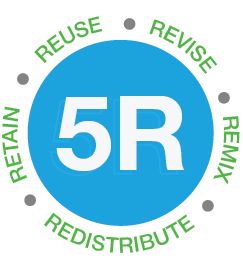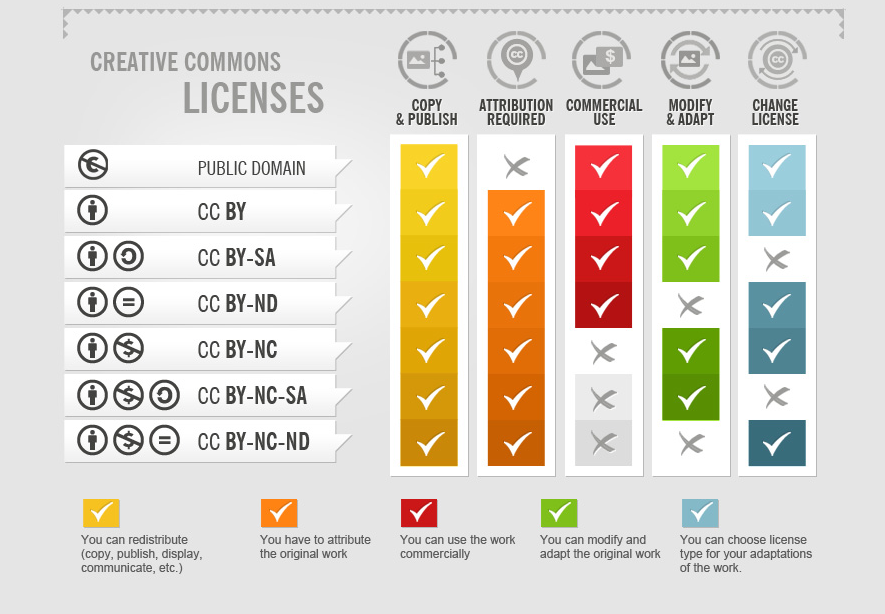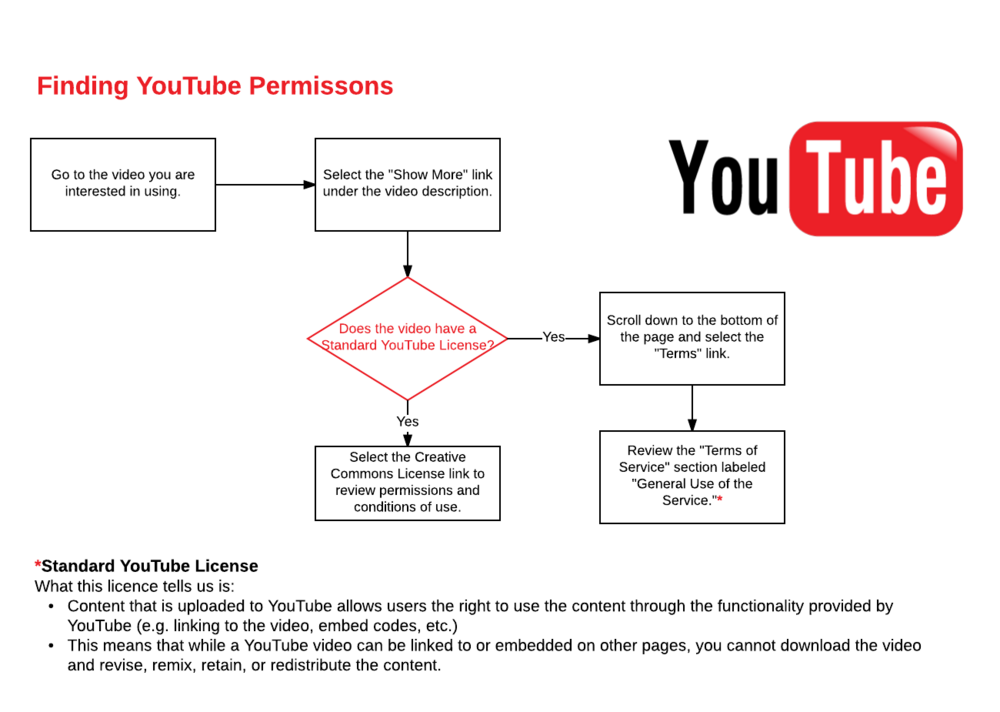Documentation:Open UBC/Guide/Faculty Open Licensing
Open Licenses Defined

Materials created by David Wiley, CC by 4.0
An open license is one which grants permission to access, re-use and redistribute a work with few or no restrictions. These types of licenses, like Creative Commons, are generally developed under the 5Rs to allow users to do the following:
- Retain - the right to make, own, and control copies of the content (e.g., download, duplicate, store, and manage)
- Reuse - the right to use the content in a wide range of ways (e.g., in a class, in a study group, on a website, in a video)
- Revise - the right to adapt, adjust, modify, or alter the content itself (e.g., translate the content into another language)
- Remix - the right to combine the original or revised content with other material to create something new (e.g., incorporate the content into a mashup)
- Redistribute - the right to share copies of the original content, your revisions, or your remixes with others (e.g., give a copy of the content to a friend)
Essentially, open licenses allow for content to be used, modified and built upon.
The type of permissions given to a user of the openly licensed item, depends on the creator and the license they have assigned to their work. The benefit of open licenses are they allow the creator to select the permissions and restrictions according to how they would like their content used.
Types of Open Licenses
Assigning Creative Commons License
To work in an open environment, it's important to assign your work an open license like the Creative Commons License. The open license allows you to a provide ways that potential users of your resource can use and attribute your material.
To assign a creative commons license to your own work, follow this workflow.
When reviewing your work, you need to consider the following:
- Are all elements of the resource original creations? If yes, do I want to share all the information openly?
- Have I used content (e.g. images, videos, etc.) from other sources? If yes, do I have the right to modify the item to use for my own pupose?
- Is the content I'm using openly licensed? If yes, what does the license allow me to do with the item?
If you are uncertain of the content you have used to develop your resource, contact the Scholarly Communications & Copyright Office.
To select a license that best represents how you would like your work used and attributed, review the following resources:
- UBC Copyright - Creative Commons License Terms
- UBC Copyright - Understanding the Different Creative Commons Licenses
- Considerations for Licensors and Licensees
There is a simple Creative Commons tool for generating an HTML, XMP, and Offline (graphic) license. Once you have selected your license, use the following:
Open Licenses and Student Work
|
Identifying Permissions
When adopting a resource, you need to be aware of how the resource can be used. This will require you to look for rights and permissions.
Rights and permissions outline how work can be used, including produced, copied, performed, published, adapted, translated or telecommunicated. It's important to remember that just because an item is available online, it does not give an individual the right to use the work however they choose.
The following is an example of finding permissions for a YouTube video.
Review Video for Infringement
Before using the video, you need to review the content for potential infringement.
- As noted by the Copyright Office guidelines on Using Videos in the Classroom,
- You are free to display online streaming videos (including Youtube videos) in the classroom, provided that the videos meet the requirements listed above, and that you also satisfy the following criteria:
- you do not break or circumvent a Digital Lock to access or obtain a copy of the work;
- there is no clear and visible notice on the website or on the work itself that prohibits the use or reproduction of the work (more than just a copyright symbol);
- the website is not questionable, infringing or clearly using the works without the copyright owner’s consent ; and
- you identify the source of the work and, if available and applicable, the author, performer, maker or broadcaster of the work.
- This means if the content is infringing on copyright (e.g. A YouTube user has uploaded the movie, "The Conjuring") you cannot display that video.
- If you cannot find the "Terms of Use" or "License" for an item, contact the Scholarly Communications and Copyright Office for assistance.
Additional Examples of Identifying Permissions
Creative Commons License Permissions
Although Creative Commons Licenses support the open use of resources, creators can assign a license that allows only specific kinds of uses. For example, a creator can assign a license that allows others to modify and adapt the original work, but under the requirement that the new resource provides attribution to the original and is shared with the open community.
To best understand Creative Commons License permissions, find the license assigned to the original work and use the following table to identify how the CC licensed work can be used and under what conditions.

Attributing Creative Commons Materials
All Creative Commons licenses require that users of the work attribute the creator. When providing attribution to a CC-licensed work, you should include:

- the author's name, screen name, or user ID, etc. If the work is being published on the Internet, it is best practice to link that name to the person's profile page, if such a page exists.
- the work's title or name (if applicable), if such a thing exists. If the work is being published on the Internet, it is best practice to link the name or title directly to the original work.
- the specific type of license the work is available under. Linking to the license will allow others to find the license terms
- The URL where the work is hosted
- Mention if the work is a derivative work or adaptation, in addition to the above, one needs to identify that their work is a derivative work i.e., “This is a Finnish translation of [original work] by [author].” or “Screenplay based on [original work] by [author].”
For in-depth examples on citing Creative Commons images, please see the Creative Commons Image Citation Guide from the UBC Copyright Site.
Resources
Looking for more information on proper ways to attribute Creative Commons licensed recourses? Check out these in-depth guides:
- How do I properly attribute a CC licensed work?: FAQ from Creative Commons
- Creative Commons best practices for attribution A set of examples of incorrect, good, and better attributions
- Attributing Creative Commons Materials A 9-page guide from Creative Commons Australia on best practices for attribution of Creative Commons licensed materials.
- How to attribute Creative Commons licensed materials for Teachers and Students: a 7-page guide for Teachers and students from Creative Commons Australia on how to attribute Creative Commons materials.




